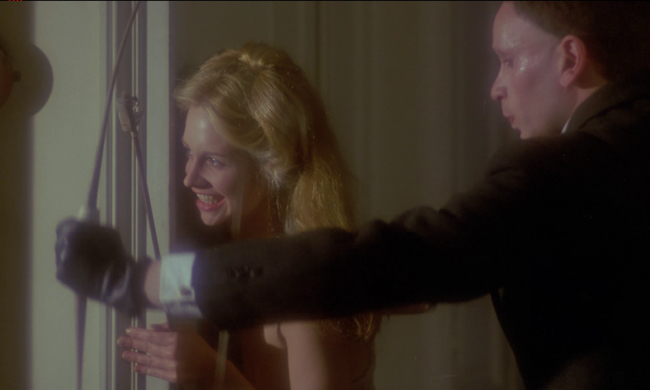
And then there's the pure sensual pleasure of transgressing all ethics and morality. 1981's Strange Case of Dr. Jekyll and Miss Osbourne (apparently the director's preferred title though it was released in France as Docteur Jekyll et les femmes) is Jekyll and Hyde by way of the Marquis de Sade. Essentially an S&M fantasy, it's also a meditation on societal hypocrisy, handsomely photographed, and featuring magnetic performances from Udo Kier and Marina Pierro. Patrick Magee also stars in this, his final feature film role before he died the following year. As the title suggests, the film also has a provocative reconfiguration of perspective to include participation from its female characters in the discussion on morality.

With the exception of the film's first scene, in which Hyde not merely tramples but attempts to rape a young girl, the entire film takes place indoors. In Jekyll's enormous, labyrinthine mansion, the candles and lamps are never lit but the lighting makes it seem as though every room has a skylight through which sunlight is constantly streaming, night and day.

The effect is to give a simultaneously warm painted quality and eerie iciness to the events. It underlines the sense of unreality, leading one to suspect that the house is meant to be taken as a metaphor for a whole country or culture. Hyde's assault of the young girl is juxtaposed with another girl (Magali Noaro) dancing ballet for Jekyll's assembled guests. Her elderly caretakers fuss and coo over the girl's appearance, telling her not to exaggerate when she complains her shoes are too tight. When she falls onto a bed, exhausted, her mother (Catherine Coste) and Lady Osbourne (Rita Maiden) carefully place her feet, instead of her head, on the pillow and then cover her with a lace veil "to keep away flies".

The dancer is the daughter of Enfield (Eugene Braun Munk), the man who first tells Utterson about Hyde in the novella. He and Utterson have very small roles here. Patrick Magee plays General Carew, normally the father of Jekyll's fiancee in previous films but here apparently unrelated to her. He has a younger daughter, Charlotte (Agnes Daems), who's so turned on by the murders Hyde begins to commit that when Hyde does get around to the room she shares with her father she comes out of hiding half naked, bending over a table and caressing a sewing machine, her father's apoplectic reaction apparently adding to her stimulation.

The General's punishment of her afterwards suggests he also unconsciously derives some pleasure from things he shouldn't. It's hard to imagine this character in the hands of any other actor; Magee's weird fervour is both over the top and completely credible.

This is the only Jekyll and Hyde I've seen, outside the versions where the two characters are of different sexes, where Jekyll and Hyde are played by different actors. For once it would be believable that no-one recognises them as the same person but since few seem to survive getting a clear look at Hyde it's kind of a wasted opportunity. Gerard Zalcberg presents an eyebrow-less, almost Nosferatu-ish Hyde while Udo Kier, who was adorable when he was young, plays Jekyll as a sweet and sensitive doctor and suitor. Passionately making out with his fiancee, Fanny Osbourne (Marina Pierro), you believe the two are really in love, something that becomes important for the climax of the film. This is one version where Jekyll's fiancee is certainly willing to understand his obsession.

In this version, Jekyll is developing a "transcendental chemistry"--as in The Two Faces of Dr. Jekyll, this isn't a Jekyll concerned so much with making people purely good but with transcending all ideas of good and evil. Unlike the Hammer film, though, this version seems to revel in the idea as men and women find themselves liberated from the stiflingly shallow morality of society. Where The Two Faces of Dr. Jekyll only argued against the potential sadism of such an outlook, Dr. Jekyll and Miss Osbourne also includes the masochism.

The actress playing the child dancer is clearly not a child. This, like the mise-en-scene, emphasises the fantasy aspect of the film. The point in its criticism of social hypocrisy is clearly not an advocacy of real unrestrained mayhem but an encouragement to allow oneself to entertain thoughts and feelings society adheres to with mindless fear. It fits in with a general trend in 70s and 80s fiction to vicariously revel in the experiences of a traditionally villainous character--it's a very pretty example, too.

Twitter Sonnet #1104
A careful card complains in potted ink.
Tremendous blooms appeared beyond the plant.
Collected troops amass within the sink.
A dish deserves a plate and legs a pant.
A tall and placid cube of water drank.
The swimmer grins to find a bounded drop.
A bubble wake rewards the fish who sank.
Attained, a floor compels the sleep to stop.
A broken turtle shoe has shown a fate.
An ankle deep in turns decides the toe.
A march collides with stumbling, steely gait.
The stripe of pants portrays a legging show.
Impossible, the diff'rent brow could tell.
A changling leech, confirmed in potion hell.

No comments:
Post a Comment